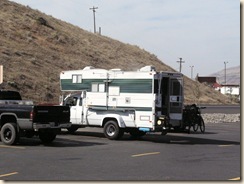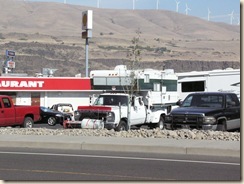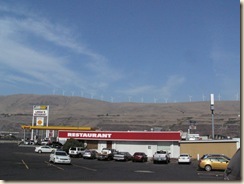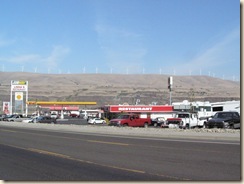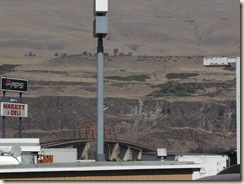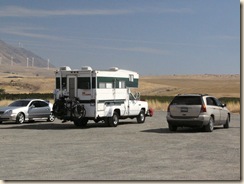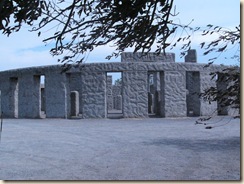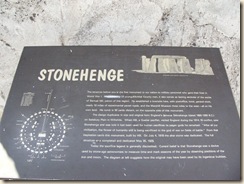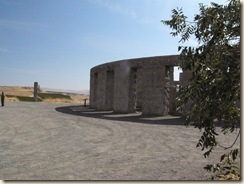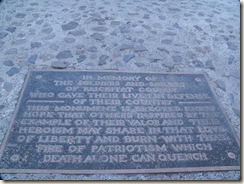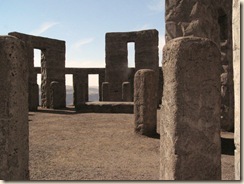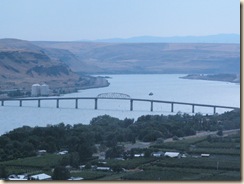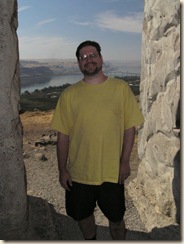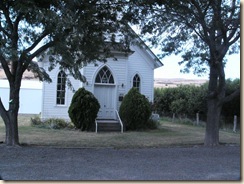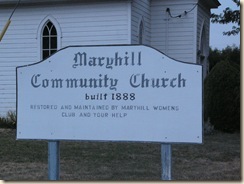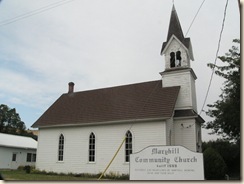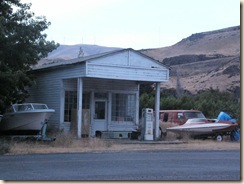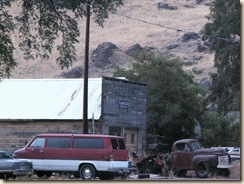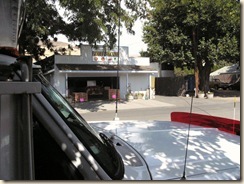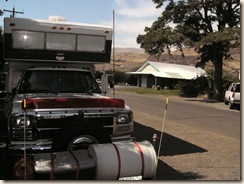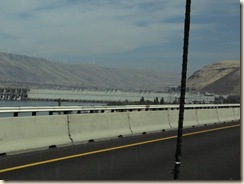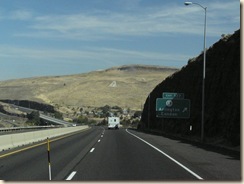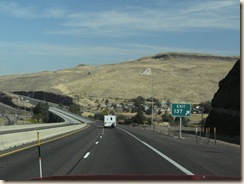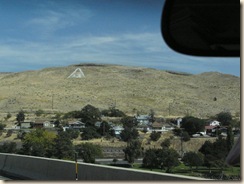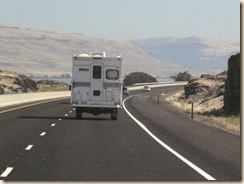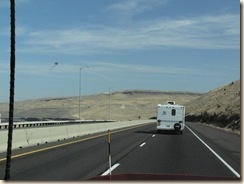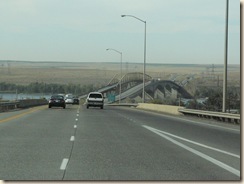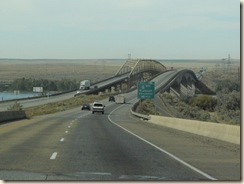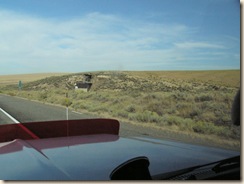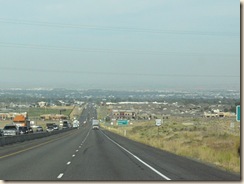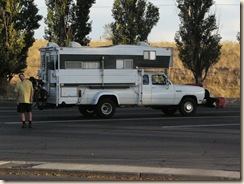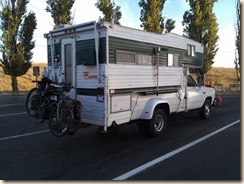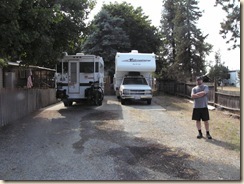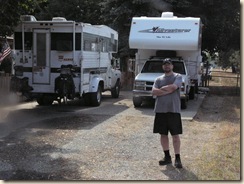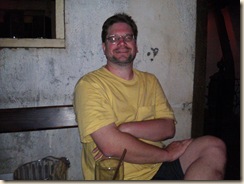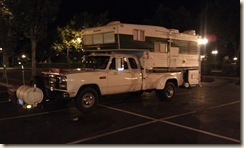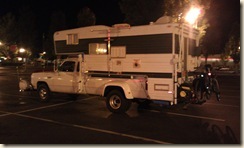JoeChiOhki
Mar 07, 2013Explorer II
The Great Northern Redneck Adventure - Trip Report (fixed)
Well, it's been far too long since this trip actually happened to me finally getting some writing done and publishing it somewhere :).
So, I've started this thread to reshare my tale for all of you on the forums :).
As I go along, I'll add new entries to this thread as each new chapter is written up.
So, here goes, starting with the Prologue to this Great Adventure :).
==================================================
Saturday, August 25, 2012
Project–Readying the Express for it’s return to the Road
For the past year, I’ve been planning what is to be my greatest cross country adventure with my RV I’ve ever done.
Part of that plan is readying my twenty year old pickup and camper for the rigors of close to 10,000 miles of travel, covering Interstates, US Highways, and in a couple cases, dirt and gravel roads.
One of the big things that needs readying for this trip is the replacement of the exhaust and the replacement of the truck’s engine and transmission cooling system, all of which are factory original, and worn beyond their expected lifespans.
Sadly, like a great many projects on a limited timeline, I didn’t photograph them, so I’ll narrate what I didn’t photograph and present what I did .
.
Cooling System Upgrades
This really started presenting itself clear back in 2009 as being well worn, when the engine was having trouble staying cool during my Eastern Oregon Ramblin’ Journey (at the time of this post, I still haven’t gotten off my lazy butt and typed that adventure up yet).
We managed to limp through on that trip, shifting into 1st gear when not really necessary to boost the air flow through the worn radiator, but the radiator ended up hanging around for three more years, as travel during the warmer months of the year hadn’t presented itself again until the Great Northern Redneck Adventure.
So, after some shopping around, I finally located a local dealer who sold solid Aluminum radiators. At the same time, I also shopped around and decided to replace my tiny factory transmission cooler with a Tru-Cool MAX transmission cooler that is made by Long Industries and normally used in the newer Ford F550 pickup trucks.
The transmission cooler was rated for a vehicle with a 45,000lb GVWR, so I figured it would be more than enough to help keep the transmission temp down.
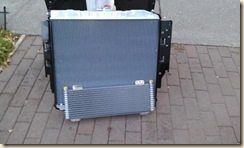
Once all my parts were obtained, I set about removing the old radiator and transmission cooler, the condition of which once removed confirmed my belief that I’d have been a damned fool to have taken a long trip with the existing hardware.

The final nail in the coffin came when I unbolted the transmission cooler from the old radiator and it promptly fell apart, the cross bars for the transmission cooler the only thing holding the radiator together.
It took roughly a day to modify and assemble my new cooler and radiator. I had wanted to move the cooler up to the front of the grill stack under the hood, but the design of the truck’s front mount area prevented this from being feasible and the new transmission cooler sadly had to go back into the sandwich (A/C Evaporator, Transmission Cooler, then Radiator) where the old one had originally been.
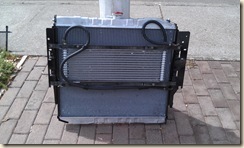
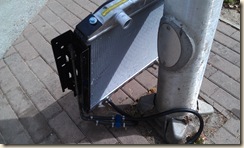
After adding all the new transmission fluid hose and the below freezing bypass valve (allows the fluid to warm up to running temp before opening to allow fluid through the cooler when the fluid’s temp is at or below 32 degrees F), I reinstalled the new radiator under the hood.
Deep Transmission Pan
Next up was changing the transmission fluid. I decided that when I upgraded the cooling capacity, I’d also upgrade the transmission fluid capacity as well. After posting a few threads on the subject earlier in the year, I researched a few different options and ended up with the DeRale Deep Transmission pan and pickup extension.
I decided to go with a steel pan vs aluminum mainly for the extra capacity and for the durability. The new pan also had a sensor bung for a transmission temperature sensor, so I also added a GlowShift transmission temp gauge.
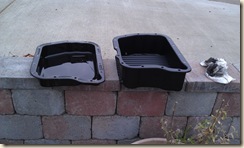
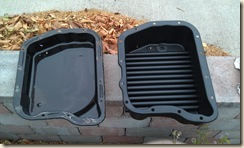
The other big reason I went with a steel pan was that the factory pan magnet would adhere to it just like it had to the factory original pan, not to mention having a drain plug puts an end to the nightmare messes of doing a fluid change of the past.
The pan on the left above is the factory original transmission pan, the pan on the right is the new pan, just a hair deeper .
.
I did have to cut a section of my truck’s exhaust off to get the new pan in place, but given the near rusted out condition of the majority of the exhaust, I wasn’t sad to see it go, the factory exhaust system was a joke.
When I added the temperature sensor assembly, there was a fairly decent debate on location of where one should measure the temperature. After a lot of back and forth between various peoples on various boards, I decided to go with the position that it was better to make sure the fluid was sufficiently cooled down before it went through the transmission.
Since my pickup is right above the sensor, I’m fairly assured of the temperature of the fluid going into the transmission is the temperature being displayed by the gauge.
New Exhaust
Now, this I had a shop do. The overall diameter was upgraded on the pipes, all heavy duty stainless steel, high flow twin cats (Can’t get rid of them in Portland, sadly) and a massive high flow twin in and out muffler (about the size of a big beer keg, this thing is massive!).
I had the new twin out exhaust exit just ahead of the passenger side rear tires and the exhaust was rerouted from the driver’s side manifold so that it no longer crossed near the transmission pan.
A ball reservoir had to be relocated off a cross member and onto the inside of a frame rail, but that was the only modification needed to be done to the truck to fit the new custom welded exhaust.

Out of everything, the exhaust replacement made the most noticeable difference in the truck’s performance as the original single cat was pretty much plugged.
One thing also done during the exhaust repairs was to have the hinged flapper valve on the passenger side exhaust manifold welded into the open position as these have a bad habit of eventually rusting to the point where they get stuck closed.
Other things fixed
Other things that were done were replacing the driver’s side air bag, changing the oil, and fixing, hopefully for the last time, the lights on the forward cargo basket.
On the camper, the furnace vent was removed so that a new steel backing plate could be installed to prevent the new eye bolt from being pulled out of the camper’s wing like it’s predecessor had.
The propane compartment was removed and the floor jacked up into position it was supposed to be in and reattached to the camper’s walls, then the compartment was repaired and reinstalled so that it actually sealed the propane compartment air tight to the outside.
The two 20lb horizontal bottles were removed and taken to a local shop to have their valves replaced to solve fill issues and the floor anchors were reinstalled to fit the newer bottles so that they would remain secured in position.
The factory original rubber line for the regulator to the compartment wall was also replaced as the original was discovered to be badly dry rotted.
The driver’s side rear jack was removed and a hole drilled in the bottom to facilitate the application of gear oil to unbind the jack’s inner bearings that had rusted over the previous winter.
The water pump was adjusted to improve it’s cycling characteristics and more of the old polybutylene cold water line was removed and replaced with Pex and brass sharkbite fittings. The output line from the hot water heater to the hot water backbone pipe was also replaced from the under-sized flex line I had used to a true 1/2” inner diameter pex line to give hot and cold water even water pump cycling characteristics.
Dedicated mount for Generator
In the past, my little champion generator was carried wrapped in a tarp on the front basket of the truck. While out of the way, it also was a pain to make use of the generator regularly, as it would need to be unpacked and unwrapped then set somewhere and chained in place and a cord run.
Since my plan for this great adventure was to make use of Walmarts and Truck Stops for a lot of my overnight sleep stops, having the generator setup in a permanent mount so I could start it as needed was necessary to save time on having to pack and unpack the generator and it’s security overnight.
So, I had a custom hinged basket made to mount the generator to. The basket is hinged so that when I’m home, I can simply remove the generator and store it in the garage and fold the basket up so that the camper can back up to the deck.
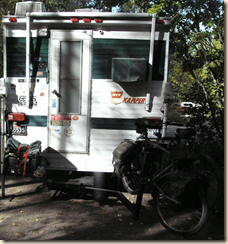
Now, all I had to do to use the generator was loosen the cargo strap and start it up. An extension cord installed to the camper carried the power from the generator to the onboard systems. When I wanted to use shore power, all I had to do was unplug the cord coming from the generator at the camper’s main outlet and plug in my loose cord.
I did have to be careful of the wind when I parked as it needed to be such that it was calm or blowing away from the camper so that I didn’t end up with exhaust being blown back up into the camper when the generator was used, even though the exhaust was directed away from the vehicle.
In the future, I think an extended exhaust pipe will need to be made to help direct the exhaust.
Mounting the 30 gallon portable waste tank for travel
Back in 2009, I obtained a nice 30 gallon barker rolling portable waste tank when I was still doing my full timing at places where there wasn’t sewer hookups for the toilet waste.
Since I moved to the island, the tank hasn’t been used for trips as I didn’t have any place to carry it setup on the camper or truck. If I had had a ladder, this would have been easily solved, but my camper had no ladder and the location where one would have been was now occupied by my air conditioner.
The tank was too big to hang off the back wall without it being the way and too awkward to carry on the forward basket, so I had to come up with an alternative solution.
In the end, I simply mounted six heavy eye screws into the structural timbers along the underside of the camper’s rear overhang so that the waste tank could be strapped upside down against the underside of the camper’s onboard waste tank.
Why upside down? So that it could sit flush, if installed right side up, the connection point for the waste hose and the vent would have been in the way.
The tank was secured in place using three ratcheting cargo straps and stayed put by being wedged there by the hitch extension, the camper’s own overhanging surround and the truck’s bumper, keeping it from being able to shift in any direction.
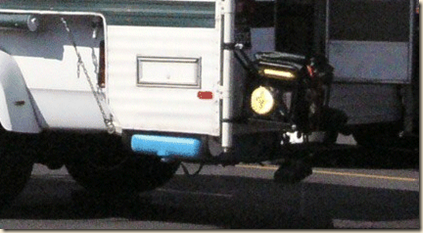
The fit was fairly tight, very little wiggle room existed, but the tank was successfully mounted in place.
Between the blue rolling waste tank that could be towed behind the truck and the white fresh water tank on the front, it was possible to now stay an extended period of time where full hookups was not available, while using the camper’s faculties as if it was on full hookups.
Other added cargo changes
Again, another thing completed without pictures, eye hooks were added to the truck bed side walls so that other tools and supplies, like my oil changing pan, could be secured along side the camper in the truck’s bed.
In the end, I carried along spare soda, scrub brushes for cleaning the truck and camper, my big steel fire poker for camp fires, my oil changing pan and a spare folding camp chair were all stored in the spare spaces in the truck’s bed. This was all in addition to the three pairs of stackable jacks, 4 12x12x4” cedar blocks and spare 4’ 2x6 that were already being stored in these spaces.
Things like the oil change pan and the scrub brushes were stored in the aft dead space behind the wheel well on the driver’s side as they wouldn’t be used while the camper was mounted.
The soda, chair and firepoker were all stored in the forward areas so they could easily be reached by the bed access doors in the camper.
Every square inch of extra storage space was utilized for this two month odyssey. Since the camper was planned to only be removed once during the trip for the extended stay near Kankakee, IL, there was no worry about the security of items stored in the truck’s bed.
So, I've started this thread to reshare my tale for all of you on the forums :).
As I go along, I'll add new entries to this thread as each new chapter is written up.
So, here goes, starting with the Prologue to this Great Adventure :).
==================================================
Saturday, August 25, 2012
Project–Readying the Express for it’s return to the Road
For the past year, I’ve been planning what is to be my greatest cross country adventure with my RV I’ve ever done.
Part of that plan is readying my twenty year old pickup and camper for the rigors of close to 10,000 miles of travel, covering Interstates, US Highways, and in a couple cases, dirt and gravel roads.
One of the big things that needs readying for this trip is the replacement of the exhaust and the replacement of the truck’s engine and transmission cooling system, all of which are factory original, and worn beyond their expected lifespans.
Sadly, like a great many projects on a limited timeline, I didn’t photograph them, so I’ll narrate what I didn’t photograph and present what I did
Cooling System Upgrades
This really started presenting itself clear back in 2009 as being well worn, when the engine was having trouble staying cool during my Eastern Oregon Ramblin’ Journey (at the time of this post, I still haven’t gotten off my lazy butt and typed that adventure up yet).
We managed to limp through on that trip, shifting into 1st gear when not really necessary to boost the air flow through the worn radiator, but the radiator ended up hanging around for three more years, as travel during the warmer months of the year hadn’t presented itself again until the Great Northern Redneck Adventure.
So, after some shopping around, I finally located a local dealer who sold solid Aluminum radiators. At the same time, I also shopped around and decided to replace my tiny factory transmission cooler with a Tru-Cool MAX transmission cooler that is made by Long Industries and normally used in the newer Ford F550 pickup trucks.
The transmission cooler was rated for a vehicle with a 45,000lb GVWR, so I figured it would be more than enough to help keep the transmission temp down.

Once all my parts were obtained, I set about removing the old radiator and transmission cooler, the condition of which once removed confirmed my belief that I’d have been a damned fool to have taken a long trip with the existing hardware.

The final nail in the coffin came when I unbolted the transmission cooler from the old radiator and it promptly fell apart, the cross bars for the transmission cooler the only thing holding the radiator together.
It took roughly a day to modify and assemble my new cooler and radiator. I had wanted to move the cooler up to the front of the grill stack under the hood, but the design of the truck’s front mount area prevented this from being feasible and the new transmission cooler sadly had to go back into the sandwich (A/C Evaporator, Transmission Cooler, then Radiator) where the old one had originally been.


After adding all the new transmission fluid hose and the below freezing bypass valve (allows the fluid to warm up to running temp before opening to allow fluid through the cooler when the fluid’s temp is at or below 32 degrees F), I reinstalled the new radiator under the hood.
Deep Transmission Pan
Next up was changing the transmission fluid. I decided that when I upgraded the cooling capacity, I’d also upgrade the transmission fluid capacity as well. After posting a few threads on the subject earlier in the year, I researched a few different options and ended up with the DeRale Deep Transmission pan and pickup extension.
I decided to go with a steel pan vs aluminum mainly for the extra capacity and for the durability. The new pan also had a sensor bung for a transmission temperature sensor, so I also added a GlowShift transmission temp gauge.


The other big reason I went with a steel pan was that the factory pan magnet would adhere to it just like it had to the factory original pan, not to mention having a drain plug puts an end to the nightmare messes of doing a fluid change of the past.
The pan on the left above is the factory original transmission pan, the pan on the right is the new pan, just a hair deeper
I did have to cut a section of my truck’s exhaust off to get the new pan in place, but given the near rusted out condition of the majority of the exhaust, I wasn’t sad to see it go, the factory exhaust system was a joke.
When I added the temperature sensor assembly, there was a fairly decent debate on location of where one should measure the temperature. After a lot of back and forth between various peoples on various boards, I decided to go with the position that it was better to make sure the fluid was sufficiently cooled down before it went through the transmission.
Since my pickup is right above the sensor, I’m fairly assured of the temperature of the fluid going into the transmission is the temperature being displayed by the gauge.
New Exhaust
Now, this I had a shop do. The overall diameter was upgraded on the pipes, all heavy duty stainless steel, high flow twin cats (Can’t get rid of them in Portland, sadly) and a massive high flow twin in and out muffler (about the size of a big beer keg, this thing is massive!).
I had the new twin out exhaust exit just ahead of the passenger side rear tires and the exhaust was rerouted from the driver’s side manifold so that it no longer crossed near the transmission pan.
A ball reservoir had to be relocated off a cross member and onto the inside of a frame rail, but that was the only modification needed to be done to the truck to fit the new custom welded exhaust.

Out of everything, the exhaust replacement made the most noticeable difference in the truck’s performance as the original single cat was pretty much plugged.
One thing also done during the exhaust repairs was to have the hinged flapper valve on the passenger side exhaust manifold welded into the open position as these have a bad habit of eventually rusting to the point where they get stuck closed.
Other things fixed
Other things that were done were replacing the driver’s side air bag, changing the oil, and fixing, hopefully for the last time, the lights on the forward cargo basket.
On the camper, the furnace vent was removed so that a new steel backing plate could be installed to prevent the new eye bolt from being pulled out of the camper’s wing like it’s predecessor had.
The propane compartment was removed and the floor jacked up into position it was supposed to be in and reattached to the camper’s walls, then the compartment was repaired and reinstalled so that it actually sealed the propane compartment air tight to the outside.
The two 20lb horizontal bottles were removed and taken to a local shop to have their valves replaced to solve fill issues and the floor anchors were reinstalled to fit the newer bottles so that they would remain secured in position.
The factory original rubber line for the regulator to the compartment wall was also replaced as the original was discovered to be badly dry rotted.
The driver’s side rear jack was removed and a hole drilled in the bottom to facilitate the application of gear oil to unbind the jack’s inner bearings that had rusted over the previous winter.
The water pump was adjusted to improve it’s cycling characteristics and more of the old polybutylene cold water line was removed and replaced with Pex and brass sharkbite fittings. The output line from the hot water heater to the hot water backbone pipe was also replaced from the under-sized flex line I had used to a true 1/2” inner diameter pex line to give hot and cold water even water pump cycling characteristics.
Dedicated mount for Generator
In the past, my little champion generator was carried wrapped in a tarp on the front basket of the truck. While out of the way, it also was a pain to make use of the generator regularly, as it would need to be unpacked and unwrapped then set somewhere and chained in place and a cord run.
Since my plan for this great adventure was to make use of Walmarts and Truck Stops for a lot of my overnight sleep stops, having the generator setup in a permanent mount so I could start it as needed was necessary to save time on having to pack and unpack the generator and it’s security overnight.
So, I had a custom hinged basket made to mount the generator to. The basket is hinged so that when I’m home, I can simply remove the generator and store it in the garage and fold the basket up so that the camper can back up to the deck.

Now, all I had to do to use the generator was loosen the cargo strap and start it up. An extension cord installed to the camper carried the power from the generator to the onboard systems. When I wanted to use shore power, all I had to do was unplug the cord coming from the generator at the camper’s main outlet and plug in my loose cord.
I did have to be careful of the wind when I parked as it needed to be such that it was calm or blowing away from the camper so that I didn’t end up with exhaust being blown back up into the camper when the generator was used, even though the exhaust was directed away from the vehicle.
In the future, I think an extended exhaust pipe will need to be made to help direct the exhaust.
Mounting the 30 gallon portable waste tank for travel
Back in 2009, I obtained a nice 30 gallon barker rolling portable waste tank when I was still doing my full timing at places where there wasn’t sewer hookups for the toilet waste.
Since I moved to the island, the tank hasn’t been used for trips as I didn’t have any place to carry it setup on the camper or truck. If I had had a ladder, this would have been easily solved, but my camper had no ladder and the location where one would have been was now occupied by my air conditioner.
The tank was too big to hang off the back wall without it being the way and too awkward to carry on the forward basket, so I had to come up with an alternative solution.
In the end, I simply mounted six heavy eye screws into the structural timbers along the underside of the camper’s rear overhang so that the waste tank could be strapped upside down against the underside of the camper’s onboard waste tank.
Why upside down? So that it could sit flush, if installed right side up, the connection point for the waste hose and the vent would have been in the way.
The tank was secured in place using three ratcheting cargo straps and stayed put by being wedged there by the hitch extension, the camper’s own overhanging surround and the truck’s bumper, keeping it from being able to shift in any direction.

The fit was fairly tight, very little wiggle room existed, but the tank was successfully mounted in place.
Between the blue rolling waste tank that could be towed behind the truck and the white fresh water tank on the front, it was possible to now stay an extended period of time where full hookups was not available, while using the camper’s faculties as if it was on full hookups.
Other added cargo changes
Again, another thing completed without pictures, eye hooks were added to the truck bed side walls so that other tools and supplies, like my oil changing pan, could be secured along side the camper in the truck’s bed.
In the end, I carried along spare soda, scrub brushes for cleaning the truck and camper, my big steel fire poker for camp fires, my oil changing pan and a spare folding camp chair were all stored in the spare spaces in the truck’s bed. This was all in addition to the three pairs of stackable jacks, 4 12x12x4” cedar blocks and spare 4’ 2x6 that were already being stored in these spaces.
Things like the oil change pan and the scrub brushes were stored in the aft dead space behind the wheel well on the driver’s side as they wouldn’t be used while the camper was mounted.
The soda, chair and firepoker were all stored in the forward areas so they could easily be reached by the bed access doors in the camper.
Every square inch of extra storage space was utilized for this two month odyssey. Since the camper was planned to only be removed once during the trip for the extended stay near Kankakee, IL, there was no worry about the security of items stored in the truck’s bed.
